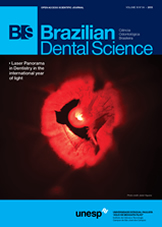The effect of metal surface treatment on bond strength interface between metal/cement
DOI:
https://doi.org/10.14295/bds.2015.v18i4.1187Resumo
Objective: This study evaluated the hypothesis that different treatments of surface upon three metal alloys for metal ceramic dental prostheses (Gold; Nickel-Chromium; Titanium) do not Influence the values of bond strength with resin cement. Material and Methods: Twenty blocks, 5x5x5 mm, of each alloy were divided into two subgroups (n = 10) according to surface treatments: 1 (Primer): sandblasting with aluminum oxide particles 110 µm (Al2O3) + Alloy Primer (Kuraray); 2 (Cojet): sandblasting with silica oxide particles with Cojet-Sand + Silane ESPE-Sil. The conditioned blocks of each group were cemented, with Panavia F, to resin blocks under constant load of 750 g/10 min. The sets were cut to obtain 4 samples with dimensions of 10x1x1 mm per block (n = 10) and the adhesive surface with approximately 1 mm2. The microtensile test was done in the universal testing machine at 1 mm/min crosshead speed. The values of bond strength and standard deviation (MPa) were: Au P: 7.33 ± 1.93d; Au C: 13.35 ± 2.18c; NiCr P: 23.56 ± 6.5b; NiCr C: 42.6 ± 5.84a; Ti P: 26.17 ± 1.94b; Ti C: 44.30 ± 2.3a. Data were analyzed by variance test (ANOVA) and Tukey’s test, p < 0.05. Results: The results indicated that the conditioning with treatment 2 increased the bond strength between the resin cement and alloys. The lowest bond strengths values were obtained with gold alloy, regardless the surface treatment. Conclusion: The results denied the hypothesis that the metallic alloys surface treatments do not alter the bond strengths values.
Downloads
Downloads
Publicado
Como Citar
Edição
Seção
Licença
TRANSFERÊNCIA DE DIREITOS AUTORAIS E DECLARAÇÃO DE RESPONSABILIDADE
Toda a propriedade de direitos autorais do artigo "____________________________________________________________________" é transferido do autor(es) para a CIÊNCIA ODONTOLÓGICA BRASILEIRA, no caso do trabalho ser publicado. O artigo não foi publicado em outro lugar e não foi submetido simultaneamente para publicação em outra revista.
Vimos por meio deste, atestar que trabalho é original e não apresenta dados manipulados, fraude ou plágio. Fizemos contribuição científica significativa para o estudo e estamos cientes dos dados apresentados e de acordo com a versão final do artigo. Assumimos total responsabilidade pelos aspectos éticos do estudo.
Este texto deve ser impresso e assinado por todos os autores. A versão digitalizada deverá ser apresentada como arquivo suplementar durante o processo de submissão.




























